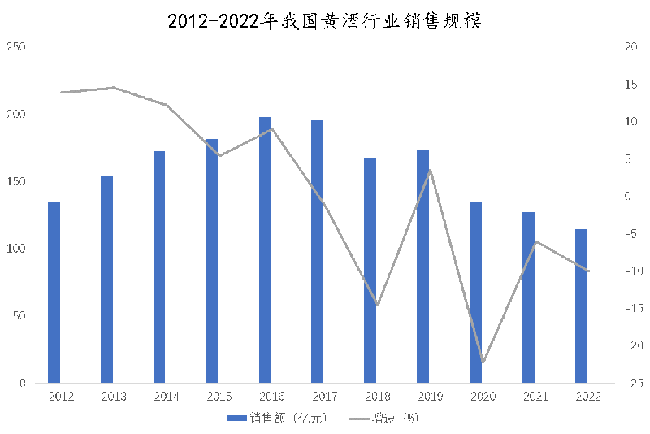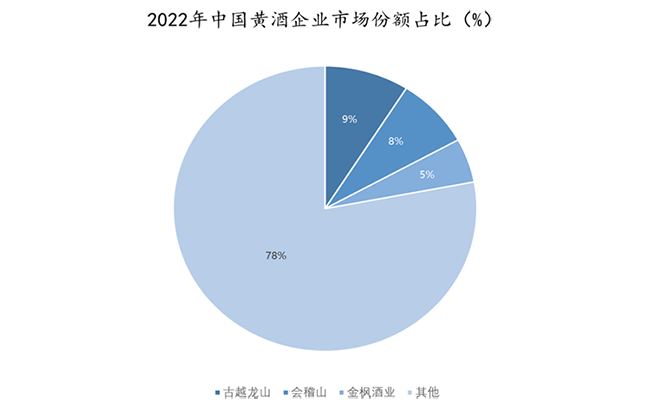

Homepage > CMRC understandings > 【CMRC understanding】 In the post-epidemic era, the rice wine industry needs to be national, high-end and young
Hits:1889 Createtime:2023-02-13 11:05:02
The sales volume of yellow rice wine market has declined sharply since the epidemic began in 2019. The yellow rice wine market belongs to the minority in the wine market, and the audience area and population are mainly in Jiangsu, Zhejiang and Shanghai and middle-aged and elderly people. Its sales volume and market volume are far less than those of beer market, Baijiu market, red wine market and foreign wine market. The sales volume of rice wine industry has been increasing from 2012 to 2016, but the growth rate has been declining, with the peak in 2016. In recent years, due to the impact of the epidemic, the sales of yellow rice wine fell from 17.33 billion yuan to 13.468 billion yuan from 2019 to 2020, and the sales fell by about 10% in the next two years, which also made the already marginalized yellow rice wine industry worse.

The rice wine industry is mainly composed of southern factions and northern factions: Shaoxing rice wine has Guyuelong Mountain and Kuaiji Mountain, etc; Suzhou rice wine includes Shazhou Youhuang and Taoyuan rice wine, etc; Anhui style rice wine includes sea god, etc; Shanghai style yellow rice wine includes Golden Maple Wine, etc; Beipai rice wine includes Jimo old wine, etc.
Glutinous rice is mainly used as raw material for rice wine products in the south and rice is mainly used as raw material in the north. Shanghai style rice wine will add some brown sugar or wolfberry to cater to the taste of people in Shanghai. Each major rice wine factory ferments and produces yeast and koji in the winter every year, and then sells them to end consumers through direct sales and distribution.

There are a large number of yellow rice wine producers, and the market share is relatively scattered. The top three listed companies are Guyuelong Mountain, Kuaiji Mountain and Jinfeng Liquor, CR3 is about 22%.

Due to the low taste and recognition, the mainstream consumption group of yellow rice wine has been confined to Jiangsu, Zhejiang and Shanghai for a long time. The publicity of rice wine is not enough, unlike Baijiu Maotai, which is positioned as "national wine" in the publicity, and Baijiu, beer and red wine brands are frequently seen in many highly exposed advertising opportunities. In addition, the current positioning of yellow rice wine is biased towards the middle-aged and the elderly, which is low end, and can not establish the brand image. Its positioning attributes lead to a small audience.
In view of the current problems of rice wine, such as niche, low-end and regionalization, the rice wine industry should strengthen brand culture construction in the post-epidemic era, pay attention to brand endorsement to make people remember the rice wine brand, and strengthen the advertising to open the national market. Innovate marketing methods and products, such as cross-border co-branding, and focus on high-end products while opening the youth market. For example, the innovation of white jade and sapphire products in Guyuelong Mountain, the innovation of cold drinks in black felt hats, and the innovation of low fruit yellow wine in golden age.
The way to break the situation of the three leading rice wine enterprises in the post-epidemic era:
Zhejiang Guyuelongshan Shaoxing Wine Co., Ltd., taking the national layout as the strategic basis, has taken the lead in occupying the national market, and is constantly developing new products and high-end yellow rice wine, of which the sapphire and white jade series of high-end yellow rice wine is highly praised, and occupies a certain market in business banquets and etiquette exchanges.
Kuaijishan Shaoxing Wine Co., Ltd. mainly focuses on historical and cultural characteristics, which is in line with the strong historical background of Shaoxing. Its yellow rice wine tastes better, thick and mellow, and is favored by local people in Jiangsu and Zhejiang. It also further opened the Shanghai market and the young people's market through the purchase of black felt hats. Its nature of cold drinking has also entered the leisure and entertainment venues.
Golden Maple Wine is mainly represented by Shanghai-style rice wine and mainly focuses on the Shanghai market, among which Shikumen is the representative of Shanghai rice wine. The ingredients will be added with materials such as wolfberry brown sugar to make the taste slightly sweet and more suitable for the taste of Shanghai and young people.
Nationalization+high-end+youth has become the consensus of the future development of the rice wine industry. In 2021, the "Fourteenth Five-Year Plan" for the development of Chinese wine industry was issued, which clarified the path and direction of the development of rice wine in the next five years, and proposed the industrial development direction of "high-end, young, and fashionable". With the inheritance and innovation development as the main line, we will gradually develop the middle and high-end rice wine, improve the rice wine products, and realize the value return of rice wine.
Yellow rice wine is a unique wine in China and has a certain consumption base, but its market share is relatively low. In the post-epidemic era, we need to seize the opportunity of economic recovery and consumption recovery, and make the rice wine market national, high-end and young. With the upgrading of consumption and the younger consumption of rice wine, the market is expected to usher in a round of changes.